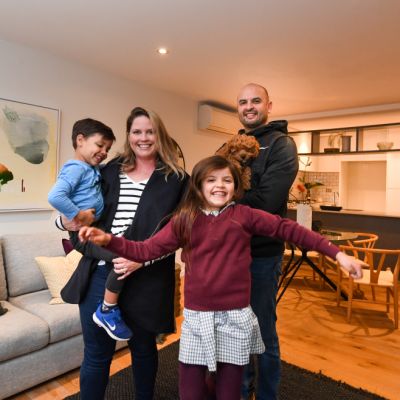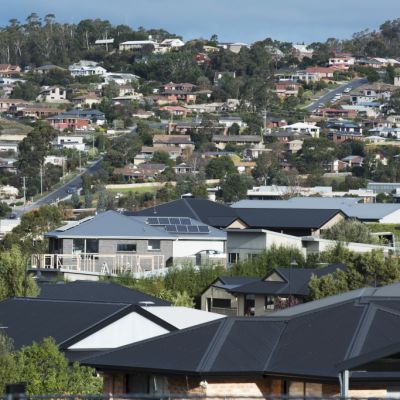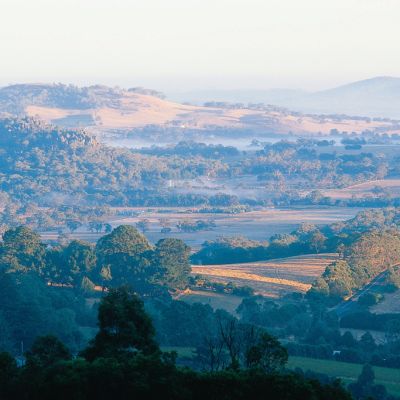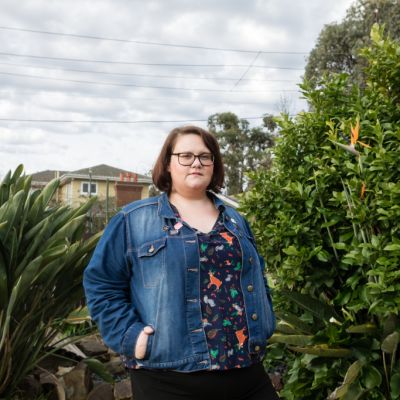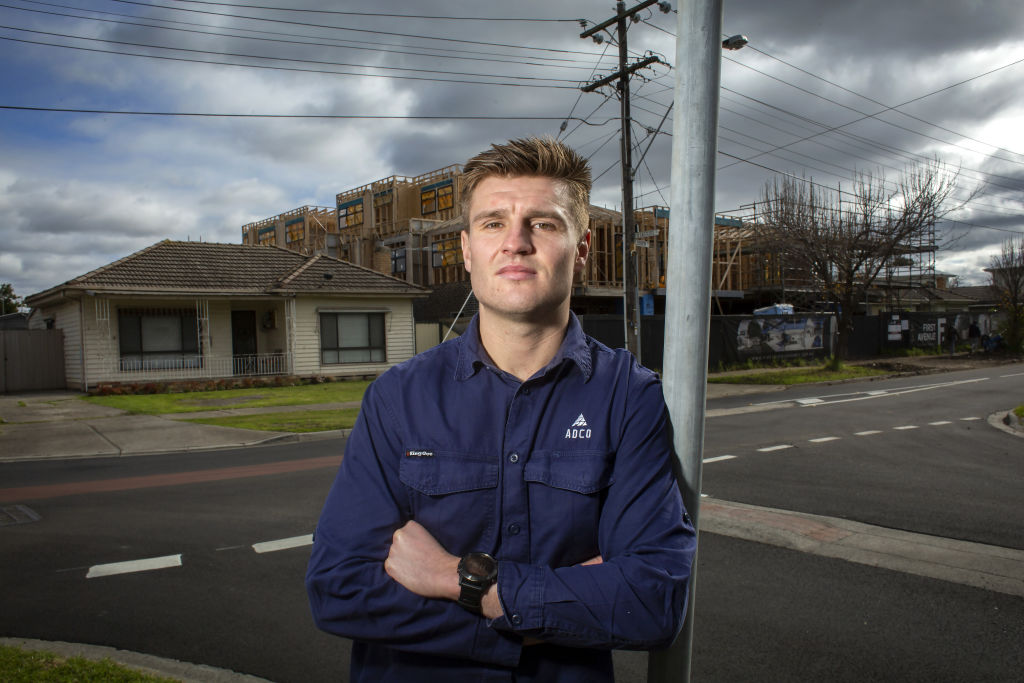
Melbourne house prices drop 3.5 per cent to median $881,000 in June quarter amid COVID-19 crisis, the sharpest fall in Australia
Melbourne house prices have fallen more than any other capital city during the COVID-19-related recession, new figures show, with experts warning there are more price falls on the way.
But as first-home buyers compete over fewer properties for sale in affordable neighbourhoods, some regions are defying city-wide trends, at least for now.
Melbourne’s median house price fell 3.5 per cent to $881,369 in the June quarter compared to three months earlier, the latest Domain House Price Report found. It’s the biggest fall in the country in percentage terms, and a drop of more than $30,000 from three months earlier.
Units were not hit as hard, with a fall of just 1.7 per cent for the same period, and both house and unit median prices were still higher than a year ago.
| HOUSE PRICES | |||||
| Capital City | Jun-20 | Mar-20 | Jun-19 | QoQ | YoY |
| Sydney | $1,143,012 | $1,165,993 | $1,034,843 | -2.0% | 10.5% |
| Melbourne | $881,369 | $913,277 | $824,580 | -3.5% | 6.9% |
| Brisbane | $582,847 | $590,930 | $569,297 | -1.4% | 2.4% |
| Adelaide | $553,036 | $552,031 | $536,859 | 0.2% | 3.0% |
| Canberra | $819,090 | $786,888 | $749,372 | 4.1% | 9.3% |
| Perth | $522,414 | $530,358 | $529,839 | -1.5% | -1.4% |
| Hobart | $529,388 | $521,843 | $481,468 | 1.4% | 10.0% |
| Darwin | $516,213 | $521,574 | $516,715 | -1.0% | -0.1% |
| National | $804,602 | $820,685 | $755,065 | -2.0% | 6.6% |
Source: Domain House Price Report, June quarter

But Domain senior research analyst Nicola Powell said this yearly rise showed how quickly the market had turned.
“It illustrates the abrupt halt we saw to a rising market,” she said. “The impact of COVID has abruptly halted the upswing we were seeing.”
| UNIT PRICES | |||||
| Capital City | Jun-20 | Mar-20 | Jun-19 | QoQ | YoY |
| Sydney | $735,417 | $749,741 | $685,499 | -1.9% | 7.3% |
| Melbourne | $537,345 | $546,818 | $504,641 | -1.7% | 6.5% |
| Brisbane | $375,285 | $391,359 | $408,792 | -4.1% | -8.2% |
| Adelaide | $319,266 | $328,928 | $326,131 | -2.9% | -2.1% |
| Canberra | $453,750 | $459,772 | $462,924 | -1.3% | -2.0% |
| Perth | $334,284 | $351,353 | $334,649 | -4.9% | -0.1% |
| Hobart | $429,464 | $435,842 | $366,189 | -1.5% | 17.3% |
| Darwin | $241,461 | $250,630 | $305,014 | -3.7% | -20.8% |
| National | $560,838 | $573,636 | $536,847 | -2.2% | 4.5% |
Source: Domain House Price Report, June quarter

The two lockdowns and the disappearance of investors and foreign buyers were to blame, Dr Powell said.
The worst-affected regions were inner Melbourne, the inner east and inner south, falling 3.9 per cent, 3.8 per cent and 1.7 per cent respectively, but Dr Powell said this was typical considering the richer areas of Melbourne tended to lead the market, up or down. Those regions span suburbs such as Toorak, South Yarra and Brighton.
| MELBOURNE HOUSES | |||||
| Region | Jun-20 | Mar-20 | Jun-19 | QoQ | YoY |
| Melbourne – Inner | $1,251,000 | $1,302,000 | $1,194,500 | -3.9% | 4.7% |
| Melbourne – Inner East | $1,410,000 | $1,465,000 | $1,280,000 | -3.8% | 10.2% |
| Melbourne – Inner South | $1,277,500 | $1,300,000 | $1,200,000 | -1.7% | 6.5% |
| Melbourne – North East | $720,000 | $722,000 | $670,500 | -0.3% | 7.4% |
| Melbourne – North West | $656,660 | $636,750 | $615,000 | 3.1% | 6.8% |
| Melbourne – Outer East | $795,000 | $792,250 | $715,000 | 0.3% | 11.2% |
| Melbourne – South East | $660,000 | $665,750 | $628,000 | -0.9% | 5.1% |
| Melbourne – West | $620,000 | $605,000 | $580,000 | 2.5% | 6.9% |
| Mornington Peninsula | $740,000 | $720,000 | $685,000 | 2.8% | 8.0% |
Source: Domain House Price Report, June quarter

Jellis Craig’s Andrew Macmillan said selling in those regions had become slightly more challenging, with buyers fighting hard for bargains despite tight supply.
“If the vendor doesn’t meet the buyer, the sales won’t transact,” he said. “Buyers now tend to sit on offer and not budge.”
Traditionally cheaper areas in the west and north-west bucked the trend, with price rises of 2.5 per cent and 3.1 per cent respectively over the quarter.
| MELBOURNE UNITS | |||||
| Region | Jun-20 | Mar-20 | Jun-19 | QoQ | YoY |
| Melbourne – Inner | $540,000 | $560,000 | $539,000 | -3.6% | 0.2% |
| Melbourne – Inner East | $685,000 | $661,500 | $625,000 | 3.6% | 9.6% |
| Melbourne – Inner South | $625,000 | $633,000 | $609,000 | -1.3% | 2.6% |
| Melbourne – North East | $515,000 | $520,000 | $460,000 | -1.0% | 12.0% |
| Melbourne – North West | $511,250 | $480,000 | $470,000 | 6.5% | 8.8% |
| Melbourne – Outer East | $600,000 | $600,000 | $528,500 | 0.0% | 13.5% |
| Melbourne – South East | $450,000 | $481,000 | $450,000 | -6.4% | 0.0% |
| Melbourne – West | $415,000 | $448,500 | $410,000 | -7.5% | 1.2% |
| Mornington Peninsula | $451,000 | $495,000 | $450,000 | -8.9% | 0.2% |
Source: Domain House Price Report, June quarter

First-home buying hopeful Jyi McWilliams is looking for a western suburbs property and said competition had become fierce in recent weeks.
He bid on an unliveable Kingsville home on Saturday and was shocked to see it sell for $690,000.
“I’m finding the prices are going up, which is making it kind of hard to get a foot in the door of the market,” he said. “That property went $115,000 over reserve, which was kinda frustrating.
“I thought coming into the market now with COVID and all that … prices would come down and that’s not happening.”
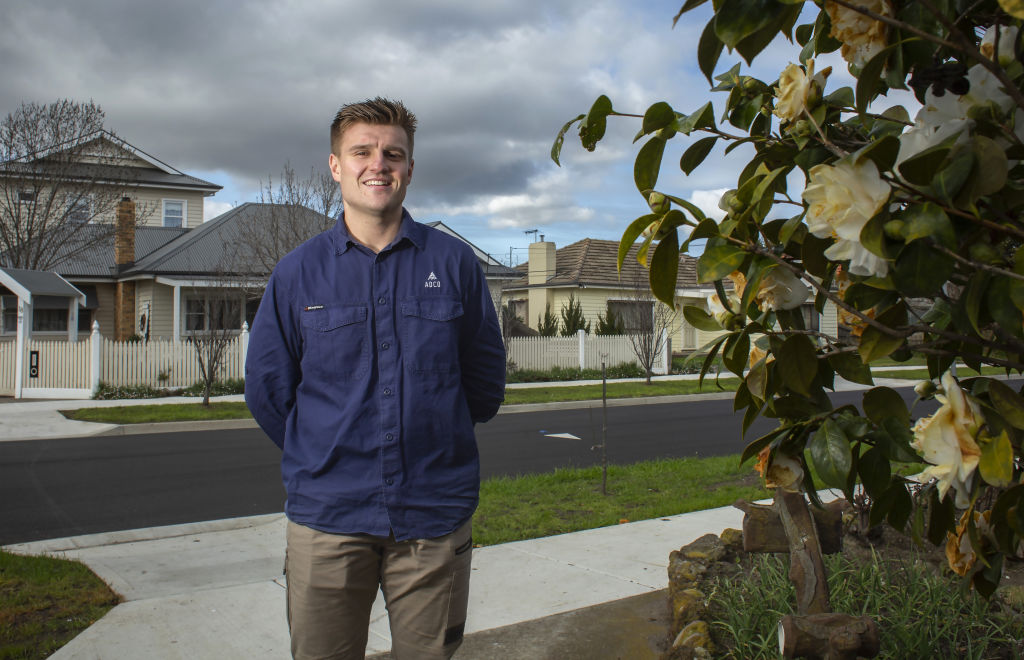
The auctioneer of the run-down, two-bedroom house Craig Stephens said the western region was teeming with first-home buyers.
“We don’t have the volume of properties we’d have going onto the market that we typically would,” he said. “We still have this undercurrent of buyers looking to get in.”
The competition from first-home buyers comes as government stimulus is on offer. Treasury figures supplied to Domain showed that 10,552 stamp duty concessions and 4010 first-home buyer grants were given out in the three months up to the end of June, just up on the previous period.
While Melbourne had the worst fall of all capital cities, it had managed to escape a massive crash due to a reduced level of activity, Dr Powell said, tipping the quieter market to continue as the city underwent its second lockdown.
“There’s many other factors and 3.5 per cent is a substantial drop over a single quarter,” she said. “But across the broader economy house prices have been insulated.
“That pullback in activity will occur across that second lockdown as well, and that will help to create a floor under prices.”
NAB chief economist Alan Oster said high unemployment and low population growth, with no clear end in sight, would mean the property market was set to decline further.
“Anything to do with unemployment and population, it’s tough,” he said. “First-home buyers are a big part of the market at the moment, higher than we’ve seen in ages.
“That’s only because investors and foreign buyers aren’t much around any more.”
Charter Keck Cramer residential director Angie Zigomanis said the recent extensions of mortgage relief and government support in the form of JobKeeper and JobSeeker payments would prevent mass sell-offs, but a greater feeling of uncertainty still loomed.
“The banks are extending that out for some, so for those that aren’t overly extended the banks will be happy [to provide relief]. But the others, the banks may start leaning on them in the next few months so some may come onto the market,” he said. “Incomes could become more tenuous for some.”
Elsewhere on the Mornington Peninsula, prices rose 2.8 per cent in the quarter.
Mr Zigomanis attributed the jump to its new reputation as a safe-haven for richer Melburnians.
“I’d expect the Mornington Peninsula is a nice place to get out of town so it’s a place a lot of people have escaped to,” he said. “So I’m not surprised if people are making a home there.”
